You will find numbers stories in many different forms – you can teach them, you can read them in books, and you can experience them in life!
They are a fantastic way of teaching number skills because they make learning real. They also link numbers to the world around us.
But what are number stories?
Number stories are simple descriptions of either real or imagined events that involve numbers. An example might be ‘Tom has three sweets, but eats two. How many does he have?’ They are used as a method of teaching different number skills.
That’s the simple version, but there is a lot more to them than that!
Number stories start easy, and can be used with even very young children. They are fantastic for simple 1:1 counting for example. (If you want to find out more about 1:1 correspondence and the best ways to teach it, then check this out.)
However, you can progress in difficulty, and cover addition, subtraction, multiplication, and pretty much any other skill in maths.
But what are the benefits? What do examples look like? How do they work? How can you invent one? And what else do you need to know?
Read on to find the answers to the questions and more…
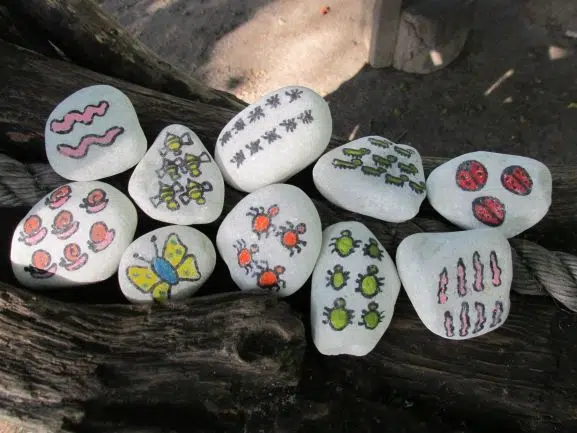
What Number Stories Are
Numbers stories are quite simply what you would expect – stories involving numbers.
There are lots of different types, which include:
- Making up simple verbal stories
- Stories involving numbers in books
- Stories you can make using objects. For example, loose parts. To find out my ultimate list of forty fantastic loose parts activities, check this out

- Number story songs (such as counting songs)
- Written word problems
They are used as a way of bringing life to number teaching! Stories generate interest and engagement. They also make numbers concrete, and relevant.
There are many benefits of teaching number stories, that I will take a look at now…
The Benefits Of Number Stories
There are many of these, including:
Stories Link Numbers To Life
This is the big one!
Stories link numbers to the world. This makes numbers relevant to children’s lives.
We teach maths to children so they can apply it in their lives, and so learning through stories makes a whole lot of sense.
Hopefully, after children have been exposed to numbers stories, they will begin to see numbers in every day situations. This could be things like how to share objects between themselves and friends, how many objects they have gathered outside, or how many children are playing in the same area as them.
Stories Are Memorable
The cognitive psychologist Jerome Bruner states that ‘stories are 22 times more memorable than facts alone.’ (Source)
Stories leave a deeper impression in our minds than just talking about numbers.
Stories Are Emotive
Linked to the last point is this one – stories can get in touch with our emotions. Even in number stories, this can be the case.
For example, ‘a cat gives birth to three cute kittens, and then one more. How many does she have?’ This will get an ‘ahh’ out of many children, because they respond to the cuteness of the kittens.
Some kind of image or video of the kittens would bring this to life even more.
Our emotions help our full minds to ‘power up’, and get much more heavily involved in the issues.
You can also link stories to what children are interested in (like superheroes). Using interests is one of the best motivators for young children (here are the other main 14).
Applying Their Knowledge
There’s a difference between being good at maths in the abstract, and being good at it in practice.
It is important that children learn to apply the abstract knowledge they learn, and number stories offer a brilliant way of doing this.
Many children know what four add four is, but it can be different when it is four dogs and then four come to join them.
The language is different! The images are different. These are not numbers, but real things, and it requires a different type of thinking.
Number stories are a good way of applying this knowledge of numbers to the world.
Problem-Solving
This is one of the best ways of using numbers stories and one of the most common. They get children thinking!
For example, if five cars are in the car park and three drive away, how can you work out the answer? What maths can you use? What strategies?
You can offer all types of problems, and the children can apply their knowledge to work them out.
Anyway, that’s enough of the theory. Let’s dive into many examples of what number stories are like in real life, and also the different skills you can teach.
I have split up the examples in order of difficulty. I have started at the easiest and progressed through the gears.
Simple Numbers Stories
You can introduce very simple number stories from a very early age.
Here are the best ways of starting them off:
Counting Songs
These are often the first exposure children get to a form of numbers story.
Some classic counting songs like 5 Little Men In A Flying Saucer, 5 Fat Sausages, and all the rest of them, are basically number stories but set to music.
There are lots of counting objects, and even some calculating. The music really helps! The more multisensory you can make learning at this stage of life the better.
Using Numbers Stones
There are many simple resources you can use to attempt number stories, and homemade number stones are a fantastic one.
These are some of the ultimate outdoor math resources. You can take a look at 50 fantastic outdoor math ideas by going here.
You basically get some stones and either draw or paint just a few objects on each.
I have some bug stones. They have different numbers of bugs on from 1 to 10.
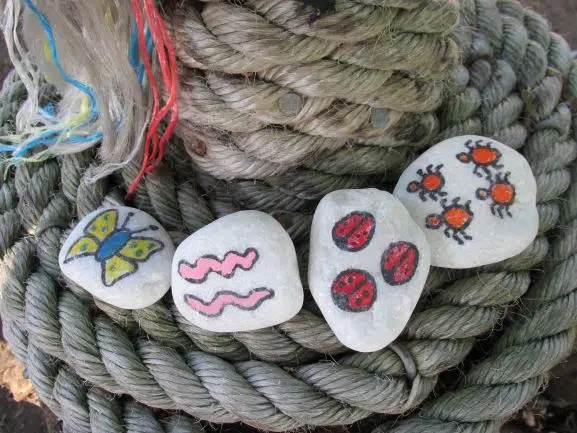
These are a nice way of just introducing a little number into stories.
I put the stones into a bag, and a child gets one out. For example, if it was two ladybirds, you say something like ‘One day two ladybirds went on an adventure.’
Then take another stone out. ‘They met four spiders’.
Continue like this! Great for 1:1 counting and saying the number names.
Using Loose Parts
You can use simple loose parts to act on short stories.
For example, you might 5 sticks and make up a story like ‘One day there were five people. One of them went away on the bus. How many are there?’
Use stones, leaves, flowers, bolts – anything you like, and you can link it to numbers through any kind of made up story.
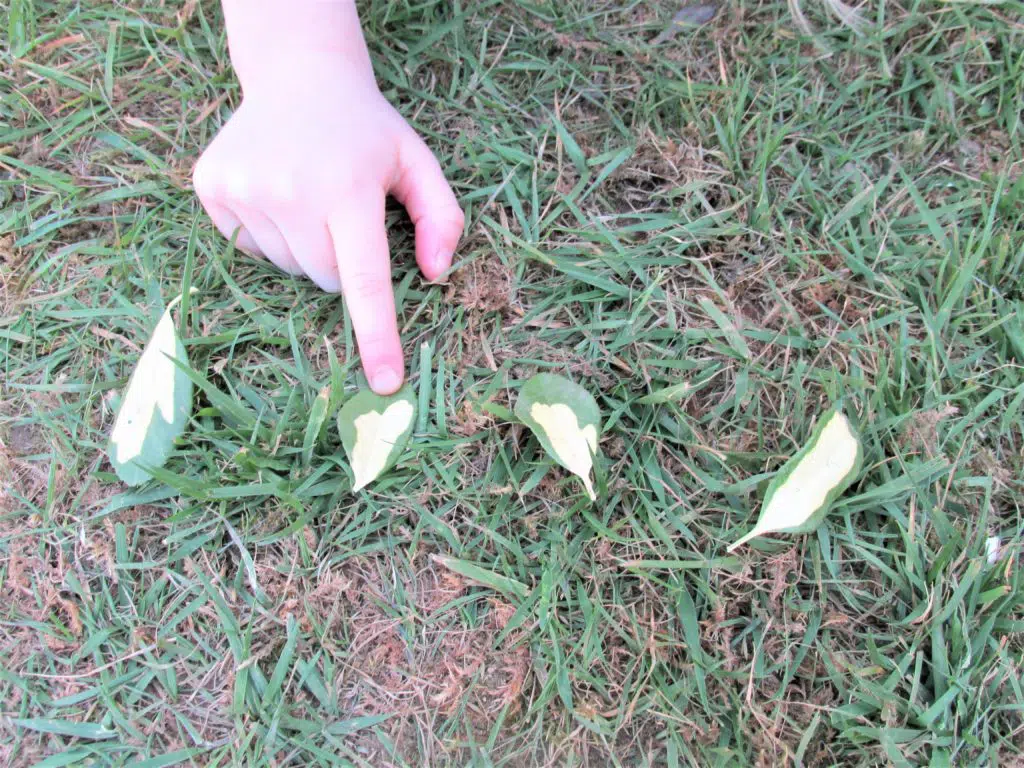
If you’re not sure about the types of resources you can use for this kind of activity, then take a look at my article about the 100 best materials for loose parts play.
1 To 1 Counting Books
There are many simple early books that are like a kind of number story. A lot of these have different quantities of things in them. A good example is this book – One Ted Falls Out Of Bed by Julia Donaldson:
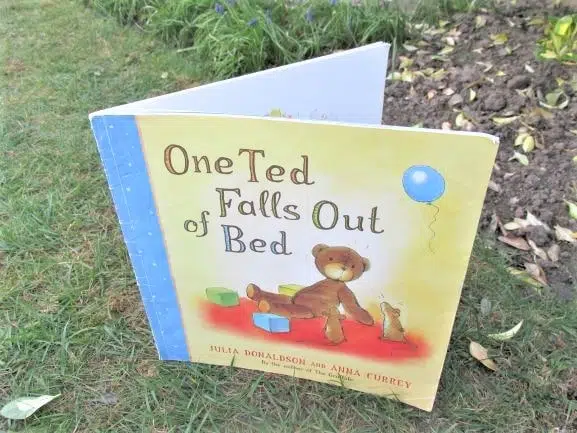
You count the bear, you count the eyes…go through the book reading and counting.
Brilliant for one-to-one correspondence, and also for number recognition often as well.
If you’re not sure what one-to-one correspondence is, then check out this essential guide.
For Finding One More Or Less
The first introduction to calculating often comes through finding one more and one less, and this is one of the best uses of number stories.
Verbal stories are good for this – e.g. Simon has three chocolates, then he eats one. How many does he have?
Mark-Making
This is another really simple one, that also combines some mark-making opportunities as well.
This is a good one to do with a small group of children. Some kind of big surface to mark-make on would be good, such as large wallpaper for example.
Make up a story! For example, ‘One day a magic bird flew through the forest. It flew over three hills.’ (All try to draw three simple hills.) ‘Then it saw the monster with four red eyes!’ (Draw the red eyes)
Any simple object you can think of, try to draw it and count at the same time.
Next Step Number Stories
When children have engaged with simple number stories, and are confident to do so, the next step is to introduce number stories involving different maths functions.
Some of the key ones for this are:
Adding
Adding can be included in many types of stories, including:
Combining – For example, ‘John has three footballs, then finds three more. How many does he have?’ This can be done with a picture, with practical objects to represent the footballs, or the children could draw their own objects
Multiple adding – For example, ‘Amelia has two oranges, then two more, then two more.’
Repeated addition like this is a good introduction to multiplication.
Subtraction
Take away – An example would be ‘Saima has 5 chocolates, then eats 3. How many left?’
Again, children could work out the answer using mental methods, objects, or pictures.
Difference – ‘Johann has 6 apples, Kim has 3. How many more does Johann have?’
Sharing
Number stories are, I would say, probably the best way of introducing the concept of sharing.
Children really understand sharing through a story, because it is something they experience all the time in life.
For example, simple stories like ‘Imran and Julie have 8 sweets. They share them. How many will they have each?’
Acting out the story practically with objects really helps. I find puppets brilliant for teaching sharing (this begins one of many fantastic math puppet activities that you can read here). Simply get some objects, and the children share them out between the two puppets.
The simplest way to introduce sharing is with halving – i.e. giving out a set of objects between people or puppets.
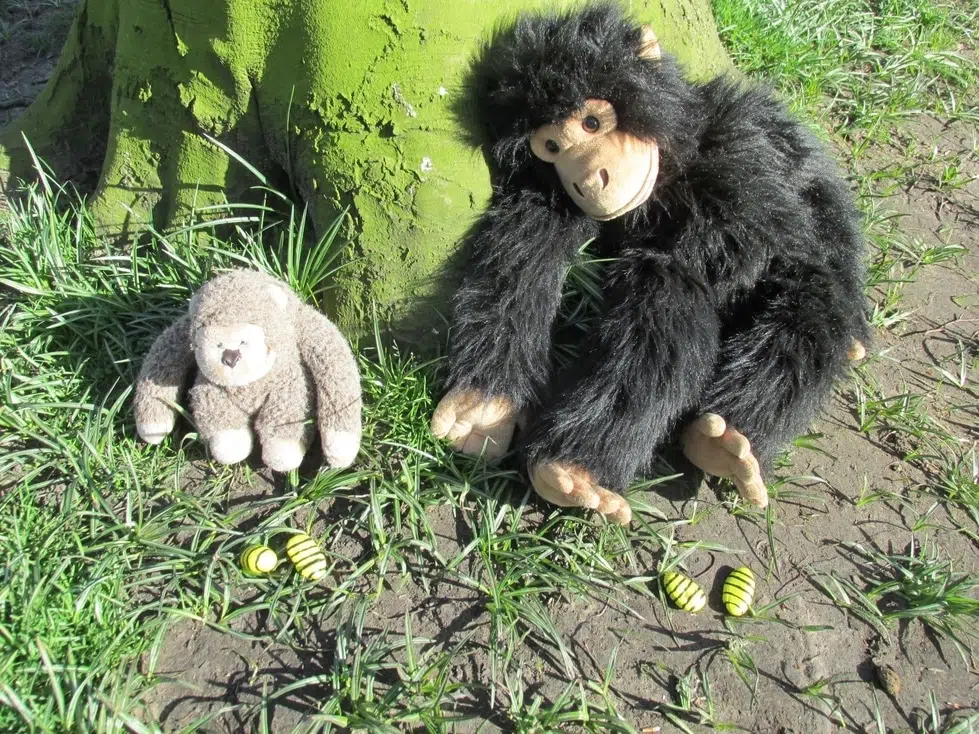
The next step is to share between three or four people. It is best to start without a remainder, although remainders will happen in play-based scenarios, and it is good for children to experience these.
It is good for stimulating their problem-solving abilities.
One More Extended
There are many books that include the concept of one more. You might not even notice the fact unless you really thought about it.
Some good examples of one more books include:
The Enormous Turnip – In this, the man tries to pull the turnip out. Then the man and his wife (one more). Then the man and his wife and the dog. Each time there is one more.
The Gingerbread Man – He is chased by a fox. Then a fox and a man etc
Chicken Licken – Chicken Licken thinks the sky is falling in! Then he is joined by Goosey Lucy. Then many more animals join them in turn (each time one more)
Books like this offer an excellent visual example of what one more is practically and with reference to the world.
Doubling
Example ‘Billy loved his three teddies so much, that he got three more. How many did he have?’
Another example might be ‘The four lady bears each had one husband. How many bears were there?’
Higher Level Number Stories
For older children, and those very confident with strategies and types of math skills already described, then number stories can be made much more complex.
At this point, the number of stories will normally be presented solely as word problems, without so much need for visuals or props. The onus is more on the children to work things out through mental methods, or their own pictures or notes.
Some of the key elements of these types of stories include:
More Than One Math Function Involved
Examples of these could be things like:
‘The farmer has nine chickens but six escape. However, he finds three and brings them back. How many does he have?’
‘The baker makes six buns, each with four cherries on. Two buns are sold. How many cherries are left?’
Higher Numbers
One way of making things more complex is simply by including higher numbers. This could be something like:
‘There are 73 ducks on the pond, but 37 fly away. How many are left?’
‘There are 103 horses in the field, but 45 jump over the fence from the next field and join them. How many are there?’
Even though these two examples use quite simple functions of addition and subtraction, the larger numbers involved require children to be clear in their methods of working out.
Multiplying
‘The baker makes four gingerbread men. Each has four buttons on it. How many buttons do they have altogether?’
‘Each ladybird has six spots. There are four ladybirds. How many spots are there?’
Dividing
This is often seen in stories as sharing out of objects.
‘There are 24 cakes and six children. They share them equally. How many do they have each?’
Fractions
These are good to include in stories about objects that can be split up into quantities. Good things are food, like large cakes, or pizzas.
‘A pizza is split into 8 pieces. John has half the pizza. How many slices does he have? Usman has a quarter. How many slices for him?’
Creating Number Stories
There are many places where number stories can come from. These include:
Write Your Own
A nice and simple suggestion!
Google ‘Math Word Problems’
You will find loads of examples of sheets and ideas that teachers and parents have already created.
Find A Picture That Tells A Story
Often a picture will really engage children. For example, it could be something simple like a picture of four children. You could ask ‘How many toes do they have altogether? How many legs?’
Pictures of things that are good for number stories include:
-Insects (ie. The ladybird with three spots went on an adventure. She met up with another ladybird with four spots. How many spots did they have?)
-Animals (Six sparrows went walking through the wood. They each found two worms. How many did they find?)
-Vehicles (Three superhero cars each have six windows. How many do they have altogether?)
-Buildings (Spiderman went to floor 11. The baddie was on floor 32. How many floors must he go up to get him?)
Link A Number Story To A Book
There are a surprisingly large number of picture books that are not obviously about numbers, but you can talk about numbers as you read them.
An example is Handa’s Surprise. In this book, you can count the fruit throughout the text. Also, it is a ‘one less’ book, as one piece of fruit gets robbed on every page.
Top Tips For Number Stories
- Include your children in the stories. They find it motivating when their names are added to them.
- Include pictures from your setting or home
- Let the children create their own!
- Use objects, songs and books
- Add emotion! Add elements of sadness, or comedy!
If you have found this article beneficial, then why not try checking out one of these:
